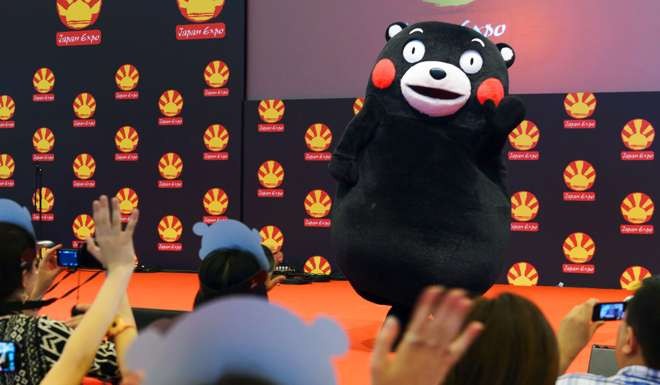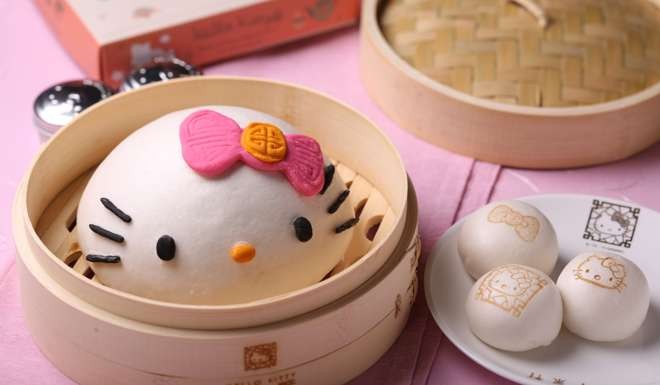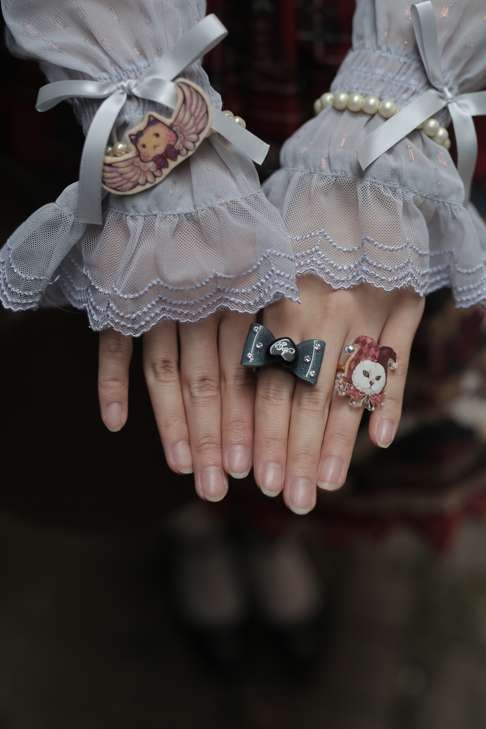Wrote an article for South China Morning Post, the most widely-read English language newspaper in Hong Kong on kawaii culture. It'll be out in the Post Magazine as well this weekend.
thanks so much Mark for editing the story!
xxxx
Elegantly dressed and
opulently coiffured, four girls sit around a table eating dainty
pastries and sipping tea. They giggle coquettishly in their puffy
dresses embellished with lace cuffs, tulle accents and oversized bows.
The scene could be from an animated version of 18th-century Versailles
but, in fact, we are in the Hit the Road café, in Causeway Bay, and
these girls – blond wigs and vivid contact lenses notwithstanding – are
most definitely Chinese.
Kat Wong, Sammi Wong
Kwok-yee, Clare Lau and Angela Leung Yuen-ting are devotees of kawaii
fashion. Their signature style, known as “Lolita”, hails from the Tokyo
youth-culture hub of Harajuku.
The brands and magazines
that gave rise to Lolita fashion knew that the Vladimir Nabokov novel
from which the style takes its name featured a young, pretty Western
girl, but perhaps not that it contained themes of paedophilia. The book
itself played no role in informing the look, the aesthetic of which is
inspired instead by the 18th-century French Rococo movement.
Having made its mark on the
international fashion scene, the style can be found from Los Angeles to
London, and even Paris, where captivated girls buy dresses from
Japanese labels such as Angelic Pretty and Baby, the Stars Shine Bright.
Angela Leung hosts “Lolita tea parties” in Hong Kong. Picture: Paul Yeung
“I love the details,” says
Leung, who first came across Lolita fashion on the internet a decade
ago. Since then, she has been an active member of Hong Kong’s Lolita
community, hosting events known as “Lolita tea parties” in a range of
venues, including The Cityview hotel, in Yau Ma Tei.
“It is really beautiful and
gorgeous,” she says. “Before I knew about Lolita, I dressed in trousers
and shorts, but then I started to wear dresses – it’s very pretty.”
There are some 500 Lolitas
in Hong Kong, according to Leung, a surprising number given that the
fashion remains niche even in Tokyo. “But some of them are active and
some are inactive,” she points out. “I know some Lolitas and they will
dress up one or two times in a year. For me, it is one or two times a
month.”
LOLITA FASHION IS JUST
one aspect of kawaii culture being embraced in Hong Kong, which has
seen installations by Japan-influenced artists in its shopping malls and
a proliferation of kawaii characters.
Similar in meaning to the
English word “cute”, kawaii references physical characteristics common
in babies and animals that provoke feelings of love and the instinct to
care for and protect. In Japan, the aesthetic’s influence has been felt
across creative disciplines, from fashion and art to design and
typography. Its distinctive qualities of roundness and soft, pastel
colours are present in architecture, food and, of course, the country’s
ubiquitous saccharine cartoon characters.
Clara Lau poses for a photograph in Causeway Bay. Picture: Paul Yeung
Since the post-war period,
popular manga has portrayed a female ideal that is sweet and endearing
but at the same time strong of spirit. With the boom in cute idols from
the 1980s onwards, girls not only wanted adorable products, they wanted
to be kawaii themselves. In Harajuku, a centre for alternative
style, independent labels sprang up to meet the demand. Many in Japan
today would rather be described as cute than beautiful or elegant.
As frivolous as a
strawberry-shaped bus stop might sound, in Japan, cuteness can determine
the success or failure of almost any product. According to the Bank of
Japan, Kumamon, the gormless bear mascot for Kumamoto prefecture,
generated an estimated 124.4 billion yen (HK$8.7 billion) in tourism and
merchandising revenue for the region in 2013-14. Kawaii mascots have
been adopted by organisations as unlikely as the Tokyo Metropolitan
Police Force and the Hamaoka Nuclear Power Plant.
The Ministry of
Foreign Affairs has even appointed Lolita models as kawaii ambassadors –
the most well-known being Misako Aoki – to tour the world promoting
Japan at expos and J-pop events. Alongside sushi, samurais and ninjas,
kawaii is one of Japan’s most recognisable cultural exports and the term
was entered into the Oxford English Dictionary in 2011.
 Kumamon, Kumamoto prefecture's popular mascot, makes an appearance at a Japan-themed festival in Paris. Picture: Kyodo
Kumamon, Kumamoto prefecture's popular mascot, makes an appearance at a Japan-themed festival in Paris. Picture: Kyodo
A stroll through Causeway
Bay confirms the popularity of Japanese street style among young Hong
Kong girls. Tokyo brands such as Liz Lisa and Cecil McBee are well
represented, and bookstores carry a range of Japanese fashion magazines
aimed at teenagers, such as Popteen and ViVi. Japanese
cosmetics on offer include fake eyelashes and pastel blushes, sold at
stores such as Sasa and the aptly named 759 Kawaiiland.
For Kat, Sammi, Angela and
Clare, who all travel frequently (each visits Japan at least twice a
year), Hong Kong is one of the best places in the world to be a Lolita
enthusiast.
“Most Hong Kong people are
looking down and playing with their mobile phones,” Leung says. “But
they are also opened-minded to other fashions.”
Hong Kong Lolita Kat Wong shows off some of her accessories. Picture: Paul Yeung
This is not necessarily the
case elsewhere. At the 40th anniversary celebrations of Hello Kitty,
held at the Museum of Contemporary Art in Los Angeles over a weekend in
late 2014, enthusiasts complained they often experienced verbal abuse
when dressed in kawaii costume. And when Kumamiki, a popular YouTube
personality from Harajuku, was asked at the event why kawaii culture is
so prolific in Japan, she answered, “Maybe it’s because Japan is …
safe?”
“When I travelled to Canada
wearing Lolita,” says Leung, “I thought the people would be more
open-minded than in Hong Kong, but it is not so. Most of them dress in
just trousers, and if they see you in Lolita they will take your photo
without permission. It’s the same in China.
“I am lucky to live in Hong Kong.”
 Hong Kong Lolitas (from left) Clara Lau, Angela Leung, Sammi Wong and Kat Wong in Causeway Bay. Picture: Paul Yeung
Hong Kong Lolitas (from left) Clara Lau, Angela Leung, Sammi Wong and Kat Wong in Causeway Bay. Picture: Paul Yeung
ALONGSIDE THE FASHION,
just as it is in Japan, kawaii design is one of the most visible
aspects of cute culture in Hong Kong. The K11 shopping mall, in Tsim Sha
Tsui, is one of several to feature character installations; themed
restaurants such as Pompompurin have appeared; and Gudetama (the popular
egg-yolk cartoon character) have popped up promoting super-cute café
cuisine.
By far kawaii’s most
popular character, Hello Kitty’s bulbous white head can be spotted on
everything from shopping bags and pyjamas to toasters and laptop
computers. The cute kitten’s appeal has been attributed to both its lack
of a mouth – expressionless, the face offers a wide range of emotions –
and a simple design that licensees can use on everything from
aeroplanes to aerobics equipment.
 Hello Kitty dim sum by Hello Kitty Chinese Cuisine restaurant in Jordan.
Hello Kitty dim sum by Hello Kitty Chinese Cuisine restaurant in Jordan.
Perhaps the best known of
Hong Kong’s kawaii-themed eateries is the Hello Kitty Chinese Cuisine
restaurant, in Jordan, where the kitten adorns chairs, lanterns and
bamboo baskets. Even the food cleverly integrates the feline design, its
mouthless visage depicted on a variety of buns and dumplings.
“I spent a lot of time and a
lot of money,” explains owner-manager Maurice Man Kwong. “It took 1½
years, because we are not just talking about one piece of merchandise,
we are talking about a whole dining concept.”
Hello Kitty has had a
presence in Hong Kong for almost 40 years and it’s not uncommon for
three generations of a family to dine at the restaurant. “The kids like
Hello Kitty because their mothers like Hello Kitty,” he says.
Talking to Man, it’s clear a
sense of escapism plays a big part in the appeal of kawaii. “In Hong
Kong, people are so tense – most are not happy,” he says. “Everything is
so expensive in Hong Kong, they work all day long and there is so
little resting time.” Man believes Hello Kitty’s simple design imparts a
sense of peace.
“Luckily, I have this
chance to do something for the Hong Kong people,” he says. “I can help
people have a short moment of happiness.”
In Japan, the psychological
and therapeutic benefits of kawaii are widely recognised. Cute robots
resembling baby harp seals, known as Paro, are used in day-care centres
for the elderly across the country and were deployed in rescue centres
in the Tohoku region after the 2011 tsunami.
“Humans have a lot of
memories,” says Paro designer Takanori Shibata, talking at his lab in
Tsukuba Science City, about 50km northeast of Tokyo. “Interacting with
Paro is like going through an old medicine chest with various drawers.
The brain is invigorated, and the process is close to reminiscence. Not
all memories are good, but by remembering things, the soul may be
calmed.”
 Paro robots interact with patients in hospitals. Picture: AFP
Paro robots interact with patients in hospitals. Picture: AFP
The desire to unwind is a motivation for Hong Kong’s Lolitas, too, Leung included.
“Dressing as a Lolita
releases pressure from work. My work as a project executive is very
serious, I need to work in detail, and rush the timeline for every
project. When you dress as a Lolita and walk in the street, you feel
more relaxed. There is a different dimension. It is a different
personality to my work life.”
Leung’s three friends all
lead double lives. Each has two Facebook accounts – and all agree it is
their Lolita identity that represents their “real” self. Their
colleagues are mostly unaware that they dress as elaborate marionettes
at the weekend. Sammi Wong, a civil engineer who wears typical work
attire during the week, says that just thinking about her make-up and
coordinating her dresses provides an “escape from reality”.
Hong Kong “kawaii hijabi” Sheema Sherry. Picture: Zenkih
FOR OTHERS IN Hong Kong, kawaii offers more than a diversion; it is a way of challenging the status quo.
Sheema Sherry, 25, arrived
in Hong Kong from Indonesia with her engineer husband two years ago and
the couple have settled in Tuen Mun. What began with her husband
encouraging her to start dressing in pastels eventually led to her
integrating kawaii fashion into her everyday dress as a Muslim. Today
she describes herself as a “kawaii hijabi”
Through her blog,
www.sheemasherry.com,
which details her love of what she calls “powerful and independent”
characters, such as Japanese anime’s Sailor Moon and “girly
princesses”, she has become an unlikely role model for Muslim youth.
 Sheema Sherry has become an unlikely role model for Muslim youth. Picture: Zenkih
Sheema Sherry has become an unlikely role model for Muslim youth. Picture: Zenkih
Sherry dresses in pinks and
purples, her hijab – the headscarf worn by Muslim women – accessorised
with flowers and ribbons framing her pink-blushed cheeks.
“What makes me happy is
that people even interview me on radicalism, because they see me and
say, ‘You are a Muslim and you look so warm, kind and cheerful. You
don’t represent anyone’s idea of radicalism,’” Sherry says. “I didn’t
know I could make people see Muslims in a better light.”
Sheema Sherry has more than 5,000 Instagram followers. Picture: Zenkih
Her sweet ensembles are
presented on her blog while her Instagram account, which features photos
taken by her husband, has more than 5,000 followers. It’s a humanising
window into the life of a regular Muslim millennial who enjoys fashion
and make-up. Comments left by visitors are almost entirely positive.
“You’re so cute and inspirational,” writes one fan.
Sherry says that dressing
kawaii has ultimately made her life better. “I have been more positive
and I have started to care more than before. I have started to know more
about myself. I learned to know myself – what people want to see from
me and what makes me happy, too.”
























